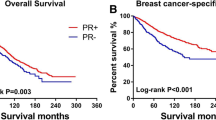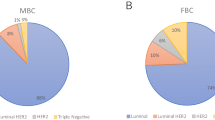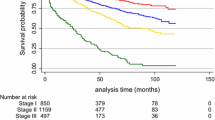Abstract
Backgrounds
Male breast cancer (MBC) is a rare disease and accounts for <1 % of all breast cancers.
Methods
We retrospectively analyzed clinicopathologic characteristics and prognosis of MBC patients who were diagnosed in our hospital between March 2002 and March 2012.
Results
The median age of diagnosis of MBC was 62 years, which was 9 years older than female breast cancer (FBC) patients. The highest proportion of MBC patients was in the 50–59-year age group. The percentage of invasive ductal carcinoma in MBC was much higher than in FBC (P = 0.000). The positive rate of estrogen receptors in MBC patients (87.9 %) was significantly higher than in FBC patients (P = 0.048), whereas HER-2 was positive in 17.2 % of MBC patients, which was significantly lower than in FBC patients (P = 0.001). There was a consistent significant difference in luminal subtypes of FBC and MBC patients (P = 0.000). The overall survival rates of MBC were significantly higher than FBC (P = 0.004). HER-2-positive patients had a statistically worse prognosis than HER-2-negative patients (P = 0.040). Lymph node metastasis and larger tumor size were also associated with poorer prognosis (P = 0.056 and P = 0.088). The level of hormones was examined in 7 patients, and abnormal hormone levels were detected in 4.
Conclusion
The FBC patients were significantly different from the MBC in clinicopathologic and prognostic characteristics. HER-2 positivity was an important factor for prognosis.




Similar content being viewed by others
References
Siegel R, Naishadham D, Jemal A (2012) Cancer statistics, 2012. CA Cancer J Clin 62:10–29
Anonymous (2008) Cancer incidence in five continents, vol IX. IARC Sci Publ, pp 1–837
Nirmul D, Pegoraro RJ, Jialal I et al (1983) The sex hormone profile of male patients with breast cancer. Br J Cancer 48:423–427
Ballerini P, Recchione C, Cavalleri A et al (1990) Hormones in male breast cancer. Tumori 76:26–28
Ravandi-Kashani F, Hayes TG (1998) Male breast cancer: a review of the literature. Eur J Cancer 34:1341–1347
Thorlacius S, Tryggvadottir L, Olafsdottir GH et al (1995) Linkage to BRCA2 region in hereditary male breast cancer. Lancet 346:544–545
Andre S, Pinto AE, Laranjeira C et al (2007) Male and female breast cancer—differences in DNA ploidy, p21 and p53 expression reinforce the possibility of distinct pathways of oncogenesis. Pathobiology 74:323–327
Anderson WF, Jatoi I, Tse J et al (2010) Male breast cancer: a population-based comparison with female breast cancer. J Clin Oncol 28:232–239
Onami S, Ozaki M, Mortimer JE et al (2010) Male breast cancer: an update in diagnosis, treatment and molecular profiling. Maturitas 65:308–314
Kiluk JV, Lee MC, Park CK et al (2011) Male breast cancer: management and follow-up recommendations. Breast J 17:503–509
Ottini L, Palli D, Rizzo S et al (2010) Male breast cancer. Crit Rev Oncol Hematol 73:141–155
Tawil AN, Boulos FI, Chakhachiro ZI et al (2012) Clinicopathologic and immunohistochemical characteristics of male breast cancer: a single center experience. Breast J 18:65–68
La Vecchia C, Levi F, Lucchini F (1992) Descriptive epidemiology of male breast cancer in Europe. Int J Cancer 51:62–66
Anonymous (2004) Male breast cancer rates rising. Health News 10:13
Ndom P, Um G, Bell EM et al (2012) A meta-analysis of male breast cancer in Africa. Breast 21(3):237–241
Tajima N, Tsukuma H, Oshima A (2001) Descriptive epidemiology of male breast cancer in Osaka, Japan. J Epidemiol 11:1–7
Zhou FF, Xia LP, Guo GF et al (2010) Changes in therapeutic strategies in Chinese male patients with breast cancer: 40 years of experience in a single institute. Breast 19:450–455
Liu T, Tong Z, He L et al (2011) Clinicopathological characteristics and survival analysis of 87 male breast cancer cases. Breast Care (Basel) 6:446–451
Bourhafour M, Belbaraka R, Souadka A et al (2011) Male breast cancer: a report of 127 cases at a Moroccan institution. BMC Res Notes 4:219
Giordano SH, Cohen DS, Buzdar AU et al (2004) Breast carcinoma in men: a population-based study. Cancer 101:51–57
Rudlowski C, Friedrichs N, Faridi A et al (2004) Her-2/neu gene amplification and protein expression in primary male breast cancer. Breast Cancer Res Treat 84:215–223
Arslan UY, Oksuzoglu B, Ozdemir N et al (2012) Outcome of non-metastatic male breast cancer: 118 patients. Med Oncol 29:554–560
Foerster R, Foerster FG, Wulff V et al (2011) Matched-pair analysis of patients with female and male breast cancer: a comparative analysis. BMC Cancer 11:335
Dakin HK, Gray S, Barnes PJ et al (2007) Clinical and pathological correlations in male breast cancer: intratumoral aromatase expression via tissue microarray. Breast Cancer Res Treat 105:169–175
Borgen PI, Wong GY, Vlamis V et al (1992) Current management of male breast cancer. A review of 104 cases. Ann Surg 215:451–457
Anderson WF, Althuis MD, Brinton LA et al (2004) Is male breast cancer similar or different than female breast cancer? Breast Cancer Res Treat 83:77–86
Giordano SH (2005) A review of the diagnosis and management of male breast cancer. Oncologist 10:471–479
Hill TD, Khamis HJ, Tyczynski JE et al (2005) Comparison of male and female breast cancer incidence trends, tumor characteristics, and survival. Ann Epidemiol 15:773–780
Pich A, Margaria E, Chiusa L et al (1999) Androgen receptor expression in male breast carcinoma: lack of clinicopathological association. Br J Cancer 79:959–964
Fogh S, Hirsch AE, Langmead JP et al (2011) Use of tamoxifen with postsurgical irradiation may improve survival in estrogen and progesterone receptor-positive male breast cancer. Clin Breast Cancer 11:39–45
Slamon DJ, Leyland-Jones B, Shak S et al (2001) Use of chemotherapy plus a monoclonal antibody against HER2 for metastatic breast cancer that overexpresses HER2. N Engl J Med 344:783–792
Salvadori B, Saccozzi R, Manzari A et al (1994) Prognosis of breast cancer in males: an analysis of 170 cases. Eur J Cancer 30A:930–935
Joshi MG, Lee AK, Loda M et al (1996) Male breast carcinoma: an evaluation of prognostic factors contributing to a poorer outcome. Cancer 77:490–498
Erlichman C, Murphy KC, Elhakim T (1984) Male breast cancer: a 13-year review of 89 patients. J Clin Oncol 2:903–909
Thomas DB, Jimenez LM, McTiernan A et al (1992) Breast cancer in men: risk factors with hormonal implications. Am J Epidemiol 135:734–748
Misra SP, Misra V, Dwivedi M (1996) Cancer of the breast in a male cirrhotic: is there an association between the two? Am J Gastroenterol 91:380–382
Calabresi E, De Giuli G, Becciolini A et al (1976) Plasma estrogens and androgens in male breast cancer. J Steroid Biochem 7:605–609
Conflict of interest
The authors declare that they have no conflicts of interest.
Author information
Authors and Affiliations
Corresponding author
About this article
Cite this article
Liu, D., Xie, G. & Chen, M. Clinicopathologic characteristics and survival of male breast cancer. Int J Clin Oncol 19, 280–287 (2014). https://doi.org/10.1007/s10147-013-0555-4
Received:
Accepted:
Published:
Issue Date:
DOI: https://doi.org/10.1007/s10147-013-0555-4




